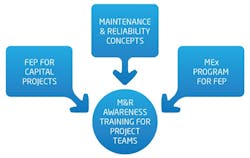Design for reliability: Breaking the “maintenance standard” threshold
Formalized maintenance standards are becoming more and more common, with facilities specifying the use of specific product brands, maintenance methods, etc., as part of a larger asset management strategy.
The value of maintaining such criteria on a capital project is likely clear to any M&R team, but project engineers often like to identify (and recommend) the latest and greatest technical solution available. How should the project team handle this situation? At what point does the value of a new technology or solution become enough to break the “maintenance threshold”?
You can explore the value and opportunity that new technologies may offer via a quantitative and qualitative lifecycle cost (LCC) analysis. Weighing known variables and risks can help you decide whether a new tool demonstrates enough value to make it worthwhile to break the maintenance and/or reliability standard and pursue it as a solution. Remember to take into account, as applicable, the challenge of working with sole suppliers for a new technology or with a supplier that holds a patent.
The goal of including M&R as stakeholders in the capital project process is to share the interests and experience of the M&R professionals who take care of the capital project assets after they are installed so as to improve overall long-term success and reliability for the project and assets. With this shared goal in mind and by using LCC as the basis for making capital project decisions, project teams can make better decisions and long-term investments.
If a maintenance standard is to be successfully broken or challenged, the identified benefits must present a better-than-average return on investment. Breaking maintenance standards and best practices typically adds not only complexity and risk, but also it reduces the potential for success.
After all, when maintenance establishes a standard, it means the necessary spare parts, training, and experience to apply it are already embedded in the operators and technicians within a given facility. Introducing new components or vendors typically means introducing an entirely new learning curve for operators, technicians, engineers, and the M&R team.
Criteria for introducing a new technology
Many organizations make the mistake of not working with stakeholders who will be responsible for 90% of an asset’s life to establish a threshold for introducing new technologies.
Don’t make that misstep. Your facility will want to establish a written threshold for engineering that calls for demonstration of a prospective new product’s technical superiority, technical advancement, and reliability. Remember, you’re talking about deviations from carefully planned maintenance and reliability standards. With any new product being considered, take into account its impact on the sequence of operation, whether it will rival existing equipment that will remain, and the skill level of the facility technicians who will need to maintain it.
Also consider whether and how you could apply DfR to the new technology, and ask around: If you can track down other maintenance and reliability teams that have introduced this new technology, inquire about the biggest challenges and surprises they encountered with the product. Finally, ensure that the OEM is open to improvements, DfR, and the long-term success of your project.
The introduction of the ISO 55000 asset management standards focusing on lifecycle cost and risk-based performance creates a seamless opportunity to integrate OEMs, suppliers, vendors, and contractors as stakeholders in the FEP of the capital project process. The foundational elements of the ISO 55000 asset management standard are clearly applied with this process. These four foundational elements include:
- Value – assets exist to provide value to the organization
- Alignment – asset management translates the organizational objectives into technical and financial decisions, plans, and activities
- Leadership – leadership and workplace culture are determinants of realizing value
- Assurance – asset management gives assurance that assets will fulfill their required purpose
By applying these tools and techniques with all the appropriate stakeholders, you’ll be able to have a significant impact on the ultimate design, reliability, and success of your projects throughout the entire life cycle of the assets and systems they support.
You’ll give your OEMs, suppliers, vendors and contractors the opportunity to perform as a partner to contribute to a higher standard of optimizing the design, maintainability, reliability, and performance of the assets they build. This provides not only an innovative way of achieving the complete vision and charter of the team, but also it demonstrates that as with quality and safety, asset management is everyone’s responsibility.



